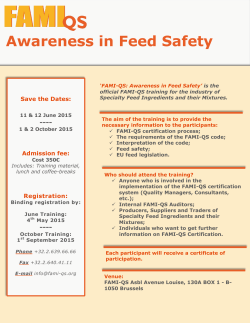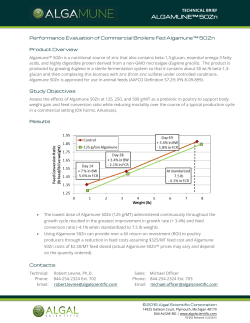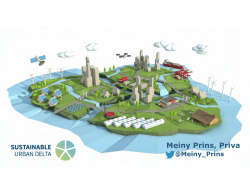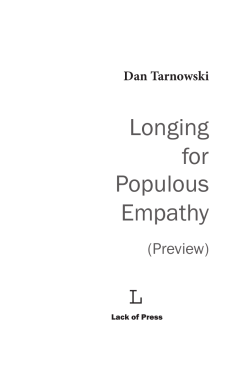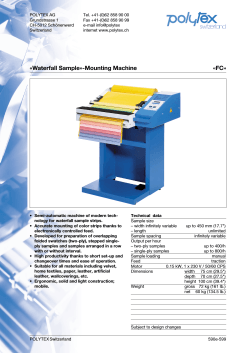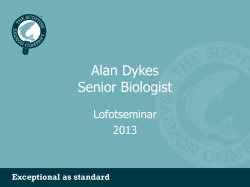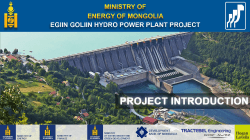
Fish Nutrition 101: Feeds and Feeding
Fish Nutrition 101: Feeds and Feeding Laura Tiu, Ph.D. OSU South Centers Piketon, Ohio Fish Nutrition 101 The objective of feeding fish • provide the nutritional requirements • • • • • good health optimum growth optimum yield minimum waste reasonable cost so as to optimize profits 2 Why so important? The feed that determines • Economic viability of the enterprise • 60-70% of variable production costs in a normal production cycle is due to feed. • Fish growth rate • Health status of the fish. • Nutrient loading (and ultimately carrying capacity) in the pond or tank • Water quality within the culture system 3 Unique Fish Nutrition Fish have a low body maintenance requirement. • Fish are cold-blooded: • Floating in the water consumes less energy than standing and walking on legs. Fish feeds are also more concentrated than those for pigs or cattle, since they do not need ‘filler’ ingredients such as fiber. Fish use oils and fats as their prime energy source - more concentrated than the carbohydrates needed by land-living animals. Most fish are carnivorous while most farmed land animals are basically herbivorous 4 Feed/Nutrition Use high quality feed. Feed must provide complete nutrition with maximum conversion efficiency. Extra protein is needed to ensure rapid growth without reducing water quality. Lower quality feeds often have poorer conversion efficiency, which results in more waste products. 5 Feed Quality The quality of feed refers to the nutritional as well as the physical characteristics of the feed that allow it to be consumed and digested by the fish. Protein - Balanced mix of amino acids builds muscle Fat -Provides dense energy for metabolism Oxidizes rapidly – becomes rancid Carbohydrate - Fish can only digest simple sugars Vitamins & Minerals - Included in mixed rations A good pellet is a package of complete diet! 6 Feed Quality - Physical The physical attributes of the feed determine the degree to which the feed affects water quality and consumption rates by the fish. • ingredients finely ground, uniform color • without fines or dust • water stability of at least 30 minutes • floating or sinking • correct size so the fish can swallow them • palatable with a good taste, smell and feel 7 Selecting a feed Know the nutritional requirements of species Feed the proper form and size Study fish feeding behavior Keep good records 8 Feed Conversion Ratio The measure of an animals efficiency at converting pounds of food to pounds of body mass. Examples: Cows 8:1, 8 lbs of food for 1 lb meat gain Pigs 4:1 Chickens 2:1 Fish Tilapia 1.7:1 Atlantic Salmon 1.2:1 9 Feeding strategies Satiation - all the feed the fish will eat daily (time consuming) Body Weight - based on estimated fish weight (3% - 5% of fish body weight per day) 10 Factors that Affect Feeding Behavior Dissolved oxygen below 4.0 ppm Cool or hot water temperatures Changes in pond water level Disturbance by seining, etc. Disease Presence of aggressive fish Time of day 11 Feeding Strategies Spread feed evenly • • • • Important to scatter feed over as much of the pond as possible Aggressive, larger fish will "hog" the feed and reduce feed efficiency If your feed application system is limited to a small area of the pond, divide the feed into two or more feeding passes Fish will learn your feeding patterns, so occasionally reverse or alter your pattern, to provide an opportunity for all fish to obtain feed 12 Feeding strategies Avoid overfeeding • When consumed feed isn't efficiently converted into tissue, the fish are overfed • FCR in fish goes down when they eat more than necessary for optimal growth • When fish are overfed, these additional waste products stimulate the development of large, unmanageable plankton populations • Nutrient and/or oxygen requirements of one or more of the populations may exceed the supply rate, resulting in a crash • Nutrient concentrations may reach toxic levels before these populations can recover. Aeration and therapeutants may be required to limit the onset of fish disease or mortality 13 Assessing Feeding Response In order to make this assessment, the following should be noted by the farmer during feeding: • How fast the fish moved towards the feed and how this reaction/behavior compares with that at previous feedings? • Whether or not the fish are interested in the feed? • What the color of the pond water is prior to feeding? • What proportion of the fish comes to the feed? • What the weather was a few days before, and on that day? Is (was) it rainy, cold or hot? 14 Adjusting the Ration Feeding rations should be adjusted either weekly or fortnightly depending on the fish’s size. • Use feeding chart • Sampling monthly 15 When NOT to feed fish • The feeding response is poor • They are feeling unwell • At least two days before harvest or transportation • The afternoon before sampling and on the sampling Day before sampling • When treatments are applied to the pond • When water temperatures are low or rainy days 16 Feed Records Records about feed usage should indicate: • type of feed(s) administered, • amount of feed given each day, • feeding response at each feeding, Records will • assess cost-effectiveness • keep track of fish inventory • project annual production • calculate cost per pound of production • Software programs helpful 17 Ordering Feed Don’t wait until the last minute • Two weeks needed for Purina Ask about feed costs and transportation costs Get several quotes Try to cooperate with other farmers Buy only what you need and can store 18 Food Storage Keep cool – slows oxidation Keep dry – prevent mold growth Keep covered-prevents rodents and bugs Keep fresh – 3 months barn, 6 mos. cooler 19 Can I make my own feed? Not practical or economical on a large scale • Can’t float • Difficult to get high quality University of Florida Extension fact sheet 20 Summary Use a good feed Feed the correct form and size Feed according to fish behavior Keep good records 21
© Copyright 2025
